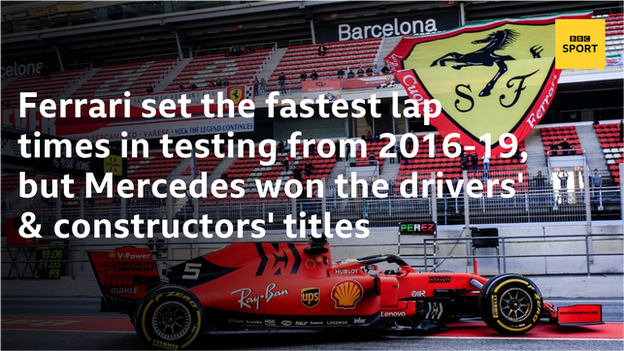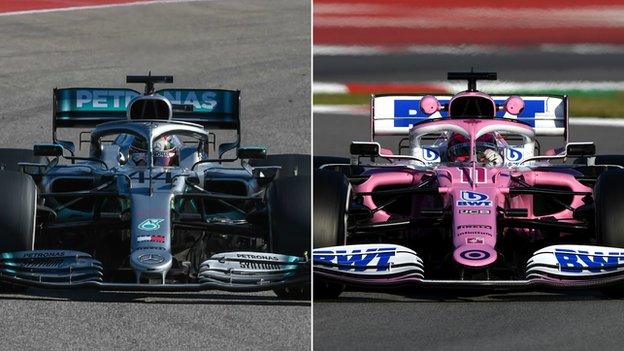Formula 1 testing: Mercedes in form; Ferrari in trouble?
- Published
- comments

Hamilton is a six-time Formula 1 world champion, one behind Germany's Michael Schumacher
The Formula 1 teams are half way through their pre-season testing programmes and world champions Mercedes could hardly have had a more impressive start to 2020.
That's not to say they will necessarily start the season in their familiar position at the front of the field, but they have certainly underlined their status as favourites.
Mercedes drivers Valtteri Bottas and Lewis Hamilton ended the test with the two fastest times - by a huge margin - and the car ran consistently and almost completely reliably throughout.
It's notoriously difficult to get any accurate sense of true form in testing - as Ferrari found out last year, when they headed to Australia for the first race thinking they were ahead, only to be thrashed by Mercedes in Melbourne.
Nevertheless, what are the key takeaways from the first three days of testing in Spain?
World champions in good shape
It's well known in Formula 1 that headline lap times in testing should be largely ignored as a means of judging true competitiveness - there are just too many variables at play.
But the fact is, no matter what tyre they were on, the Mercedes was the fastest car in Barcelona this week.
This is unusual for Mercedes, because they usually take a very low-key approach to winter testing, running heavy on fuel and just getting on with their programme, with the reassurance that they will be there or thereabouts when it matters and therefore have no need to stretch the car at this stage.
There is no reason to believe Mercedes have changed their approach to pre-season - so to see Bottas and Hamilton sitting so convincingly at the top of the times is a worrying sign for their rivals.
Bottas said the car was doing exactly what the drivers wanted.
"The main improvements are the stability we've had with the car," he said. "Actually the rear end of the car feels really stable and makes it very drivable.
"I would say the balance through the entire speed range, from high to low-speed corners, is more together than in last year's car. That's what we were aiming for and I don't want to say much more about it. At the moment we have found no negatives compared to last year yet and that's positive."
On top of that, the team seemed to be buzzing about their development of a new technology, known as 'dual-axis steering', which caught all their rivals on the hop.
When the existence of this device emerged on Thursday, technical director James Allison could hardly keep the smile off his face, his delight at stealing a march on their rivals clear to see.
"It's an innovative idea which allows the drivers an extra dimension of control on the steering system," Allison said. "Why we do it, exactly how it works and all those sorts of things, we'd rather keep those to ourselves. But we hope it's an innovation that will bring an advantage during the season.
"It's an example of how this team is always pushing to try to find new ways to make our car quicker and it's just great fun having it at the track."
Hamilton made the same point - and he also seemed enthusiastic about the way things were going on a personal basis.
"I really do feel the best I've ever felt," said the 35-year-old, after completing a race-distance run on Thursday. "I've never done the race run and got out and asked if we could keep going. We just ran out of tyres.
"That's the first time in 13 years that I've asked to continue testing - because I don't like testing. I race because I love racing other cars. I don't like driving around on my own on the track."
Despite impressions, Hamilton said he believed the opposition would provide him a sterner test this season as he bids to equal Michael Schumacher's all-time record of seven world titles.
"I'm hopeful that in this last year of this era of car, the gap has closed," he said. "You saw it at the end of last year - the gap was closing between Ferrari and Red Bull and I anticipate that will be the same this year. We're going to have a closer battle and I'm down for that.
"That's what I think everyone wants to see and, from my point of view, it makes it more rewarding when it goes the way that I want it to go."

Concern for Ferrari?
The signs coming out of Ferrari were not good from the very start of the test.
While Mercedes hit the ground running, the red cars were not doing anything like the same pace. And the impression that they were struggling was confirmed by team boss Mattia Binotto on Friday.
"The others are faster than us at the moment, I believe," Binotto said. "How much faster I think it's really difficult to judge and we'll go through all the data in the next days, but I don't think we are as fast as them at the moment.
"Do we have any concerns? Certainly, yes, when you are not as fast as you would like to be. I've seen certainly Mercedes, and Red Bull, very fast in these first days."
Binotto admitted he was "not as optimistic as last year". But the caveat here is that Ferrari's optimism was misplaced in 2019.
They - and Mercedes, too, it has to be said - left Spain last year believing that the Italian cars had an advantage over the field, only to find when they arrived in Australia that in fact Mercedes were in front and Ferrari lagging well behind.
As a result of that, Ferrari have changed their approach to testing this year, deciding to spend this first week fully understanding the car before exploring its performance at next week's second test.
But Binotto said he had concerns that if they had gone for performance this week, it would not have been there.
He said that last year "the lap time was easier to find", adding: "While it is true we did not focus on set-up work or performance, it seems it is more difficult. The competitors apparently are very strong but we should not forget the story of last year and let's wait until next week and Australia to better understand the true picture."
The controversy of 'the pink Mercedes'

Lewis Hamilton's Mercedes of 2019 against Sergio Perez's Racing Point for this season
The Racing Point drew a lot of attention.
One reason was that it was setting pretty decent lap times. Sergio Perez was second fastest on the second day, the Mexican said the team had made "a very good step", and a number of rival drivers and team bosses agreed that the car looked quick - Red Bull's Alexander Albon said they were "looking very good".
But the main talking point was just how much the car resembled the 2019 Mercedes - comparing pictures of the two cars, the Racing Point appeared almost a carbon copy in many areas, including the front wing, nose, front suspension and aerodynamic devices behind the front wheels.
Racing Point admitted that they had copied the Mercedes. The reasoning, they said, was that they were finding with their previous car concept - based on Red Bull's design approach - that their development was slowing down.
They pointed out that they already bought the engine, gearbox and various aspects of the suspension from Mercedes, so why not copy that car instead, especially as it had won the past six world championships?
The issue was that it meant a complete change of car philosophy - Mercedes use a low-rake approach in contrast to Red Bull's high rake, meaning the Mercedes runs flatter front to back in contrast to the Red Bull's nose-down, rear-up stance. This means different airflow structures around the car.
"From the outside, it probably looks like 'they have just copied a Mercedes'," said technical director Andrew Green. "But to copy something means nothing unless you understand what you are doing, otherwise it doesn't work. Unless you understand the philosophy behind every single component and what it's doing, you'll never get it to work.
"It was putting our faith in the aerodynamics team to say: 'Go and understand this and let's see if we can replicate it. Is it better than what we are currently doing? We will find out.' I'm very proud of what the team have done."
Both Green and team principal Otmar Szafnauer were adamant that the car was their own work, with no help from Mercedes, despite the commercial and technical relationship between the two. F1 rules define 'listed parts' that teams have design themselves, which are the chassis and aerodynamic surfaces, and this had been complied with, they said.
"I can tell you absolutely, categorically all those designs are Racing Point from absolute scratch," Green said. "There has been no transfer of information on listed parts from Mercedes. They have never contemplated it; we have never asked for it.
"What you see is what people have drawn from looking at pictures of Mercedes. We've utilised what we can see. There's other teams taking pictures. There's a pit lane full of photographers employed by the teams to take pictures of other people's cars. All we did was utilise that information."
Nevertheless, the striking resemblance between the two cars has reopened a contentious debate within F1 about satellite teams and the degree of similarity that should be allowed between two cars produced by entities that, according to the rules, have to produce their own design.
This has been rumbling on and off since Haas entered the sport in 2016 with an approach that sees them buying every part of the car from Ferrari they are allowed to.
The question at the heart of the Racing Point controversy is this - philosophically, if a team produces an effective facsimile of another car, does that constitute it being "designed by" them, as the rules dictate?
McLaren and Renault are not happy about this situation. They are the teams that have most to lose as the ones who finished fourth and fifth last year, and Racing Point's likely closest rivals, and they feel the FIA should be doing more to prevent it occurring.
It is a topic that will run and run as the 2021 rules continue to take shape in the background during the early months of this year.

*So far - the second phase of 2020 pre-season testing runs from 26-28 February
Renewed hope for Williams
This time last year, Williams were in a dark place. They had missed more than half the first test because the car was not ready on time, and when it did run, it was miles off the pace of any other car.
This was a precursor to the worst season in their history, a year spent in a race of their own at the back, and which led to some major soul-searching.
The contrast this year was stark. For one, the Williams was the first car on track at the start of testing, something the team described as "cathartic".
"I have a smile on my face and it hasn't come off since Wednesday morning," deputy team principal Claire Williams said. "Getting your car out first doesn't win you any prizes but it was another milestone on our journey to recovery and it was important to return a bit of pride and dignity to the team after last year."
Beyond the symbolism of that moment, though, restructuring changes made at Williams over the past year seem to have got the team back on track. When it was running, the Williams appeared to be in much better shape than last year, with George Russell in particular usually somewhere in the middle of the times.
"The drivers feel the car is a lot more balanced and stable than last year so we are in a good place," Williams said.
She added that there was "a lot more work to do" but she felt confident enough to set a target of fighting for a place in the second part of qualifying and "a position in the race that brings our pride back and George and Nicholas (Latifi) have the opportunity to fight with the midfield competitors."
Don't expect miracles, but at this early stage it does at least look like Williams will be able to compete with other teams.
Fastest lap times per team, first pre-season test
1 Mercedes (Valtteri Bottas) 1:15.732 (ultra-soft tyre)
2 Renault (Esteban Ocon) 1:17.102 (soft tyre)
3 Racing Point (Lance Stroll) 1:17.338 (soft)
4 Alpha Tauri (Daniil Kvyat) 1:17.427 (soft)
5 Alfa Romeo (Antonio Giovinazzi) 1:17.469 (soft)
6 Red Bull (Max Verstappen) 1:17.636 (hard)
7 McLaren (Carlos Sainz) 1:17.842 (medium)
8 Ferrari (Sebastian Vettel) 1:18.154 (soft)
9 Williams (George Russel) 1:18.168 (medium)
10 Haas (Romain Grosjean) 1:18.380 (medium)
